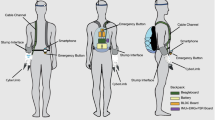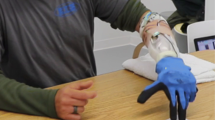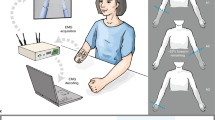Abstract
At present, albeit the dexterous hand prostheses of multiple degrees of freedom (DOFs) have become prosperous on the market, the user’s demand on intuitively operating these devices have not been well addressed so that their acceptance rate is relatively low. The unintuitive control method and inadequate sensory feedback are frequently cited as the two barriers to the successful application of these dexterous products. Recently, driven by the wave of artificial intelligence (AI), a series of shared control methods have emerged, in which “bodily function” (myoelectric control) and “artificial intelligence” (local autonomy, computer vision, etc.) are tightly integrated, and provided a new conceptual solution for the intuitive operation of dexterous prostheses. In this paper, the background and development trends of this type of methods are described in detail, and the potential development directions and the key technologies that need breakthroughs are indicated. In practice, we instantiate this shared control strategy by proposing a new method combining simultaneous myoelectric control, multi-finger grasp autonomy, and augmented reality (AR) feedback together. This method “divides” the human sophisticated reach-and-grasp task into several subtasks, and then “conquers” them by using different strategies from either human or machine perspective. It is highly expected that the shared control methods with hybrid human-machine intelligence could address the control problem of dexterous prostheses.
Similar content being viewed by others
References
Atkins D J, Heard D C Y, Donovan W H. Epidemiologic overview of individuals with upper-limb loss and their reported research priorities. J Prosthet Orthot, 1996, 8: 2–11
Belter J T, Segil J L, Dollar A M, et al. Mechanical design and performance specifications of anthropomorphic prosthetic hands: A review. J Rehabil Res Dev, 2013, 50: 599–618
Micera S, Carpaneto J, Raspopovic S. Control of hand prostheses using peripheral information. IEEE Rev Biomed Eng, 2010, 3: 48–68
Fougner A, Stavdahl O, Kyberd P J, et al. Control of upper limb prostheses: Terminology and proportional myoelectric control: A review. IEEE Trans Neural Syst Rehab Eng, 2012, 20: 663–677
Kuiken T A, Li G, Lock B A, et al. Targeted muscle reinnervation for real-time myoelectric control of multifunction artificial arms. JAMA, 2009, 301: 619–628
Farina D, Vujaklija I, Sartori M, et al. Man/machine interface based on the discharge timings of spinal motor neurons after targeted muscle reinnervation. Nat Biomed Eng, 2017, 1: 0025
Collinger J L, Wodlinger B, Downey J E, et al. High-performance neuroprosthetic control by an individual with tetraplegia. Lancet, 2013, 381: 557–564
Osborn L E, Dragomir A, Betthauser J L, et al. Prosthesis with neuromorphic multilayered e-dermis perceives touch and pain. Sci Robot, 2018, 3: eaat3818
Fang Y, Hettiarachchi N, Zhou D, et al. Multi-modal sensing techniques for interfacing hand prostheses: A review. IEEE Sens J, 2015, 15: 6065–6076
Farina D, Ning Jiang D, Rehbaum H, et al. The extraction of neural information from the surface EMG for the control of upper-limb prostheses: Emerging avenues and challenges. IEEE Trans Neural Syst Rehab Eng, 2014, 22: 797–809
Englehart K, Hudgins B. A robust, real-time control scheme for multifunction myoelectric control. IEEE Trans Biomed Eng, 2003, 50: 848–854
Ning J, Dosen S, Muller K R, et al. Myoelectric control of artificial limbs: Is there a need to change focus? IEEE Signal Process Mag, 2012, 29: 152–150
Castellini C, Artemiadis P, Wininger M, et al. Proceedings of the first workshop on Peripheral Machine Interfaces: Going beyond traditional surface electromyography. Front Neurorobot, 2014, 8: 22
Atzori M, Gijsberts A, Castellini C, et al. Electromyography data for non-invasive naturally-controlled robotic hand prostheses. Sci Data, 2014, 1: 140053
Geng W, Du Y, Jin W, et al. Gesture recognition by instantaneous surface EMG images. Sci Rep, 2016, 6: 36571
Zia ur Rehman M, Gilani S, Waris A, et al. Stacked sparse autoencoders for EMG-based classification of hand motions: A comparative multi day analyses between surface and intramuscular EMG. Appl Sci, 2018, 8: 1126
Olsson A E, Sager P, Andersson E, et al. Extraction of multi-labelled movement information from the raw HD-sEMG image with time-domain depth. Sci Rep, 2019, 9: 7244
Phinyomark A, Scheme E. EMG pattern recognition in the era of big data and deep learning. Big Data Cognitive Comput, 2018, 2: 21
Velliste M, Perel S, Spalding M C, et al. Cortical control of a prosthetic arm for self-feeding. Nature, 2008, 453: 1098–1101
Hochberg L R, Bacher D, Jarosiewicz B, et al. Reach and grasp by people with tetraplegia using a neurally controlled robotic arm. Nature, 2012, 485: 372–375
Ahmadizadeh C, Merhi L K, Pousett B, et al. Toward intuitive prosthetic control: Solving common issues using force myography, surface electromyography, and pattern recognition in a pilot case study. IEEE Robot Automat Mag, 2017, 24: 102–111
Fazli S, Mehnert J, Steinbrink J, et al. Enhanced performance by a hybrid NIRS-EEG brain computer interface. Neuroimage, 2012, 59: 519–529
Bohg J, Morales A, Asfour T, et al. Data-driven grasp synthesis-A survey. IEEE Trans Robot, 2014, 30: 289–309
Lenz I, Lee H, Saxena A. Deep learning for detecting robotic grasps. Int J Robot Res, 2015, 34: 705–724
Levine S, Pastor P, Krizhevsky A, et al. Learning hand-eye coordination for robotic grasping with deep learning and large-scale data collection. Int J Robot Res, 2018, 37: 421–436
Cipriani C, Antfolk C, Balkenius C, et al. A novel concept for a prosthetic hand with a bidirectional interface: A feasibility study. IEEE Trans Biomed Eng, 2009, 56: 2739–2743
Stephens-Fripp B, Alici G, Mutlu R. A review ofnon-invasive sensory feedback methods for transradial prosthetic hands. IEEE Access, 2018, 6: 6878–6899
Markovic M, Dosen S, Cipriani C, et al. Stereovision and augmented reality for closed-loop control ofgrasping in hand prostheses. J Neural Eng, 2014, 11: 046001
Yang D, Gu Y, Thakor N V, et al. Improving the functionality, robustness, and adaptability of myoelectric control for dexterous motion restoration. Exp Brain Res, 2019, 237: 291–311
Hahne J M, Schweisfurth M A, Koppe M, et al. Simultaneous control of multiple functions of bionic hand prostheses: Performance and robustness in end users. Sci Robot, 2018, 3: eaat3630
Cipriani C, Zaccone F, Micera S, et al. On the shared control of an EMG-controlled prosthetic hand: Analysis of user-prosthesis interaction. IEEE Trans Robot, 2008, 24: 170–184
Quigley M, Salisbury C, Ng A Y, et al. Mechatronic design of an integrated robotic hand. Int J Robot Res, 2014, 33: 706–720
Zhuang K Z, Sommer N, Mendez V, et al. Shared human-robot proportional control of a dexterous myoelectric prosthesis. Nat Mach Intell, 2019, 1: 400–411
Ghazaei G, Alameer A, Degenaar P, et al. Deep learning-based artificial vision for grasp classification in myoelectric hands. J Neural Eng, 2017, 14: 036025
Markovic M, Karnal H, Graimann B, et al. GLIMPSE: Google Glass interface for sensory feedback in myoelectric hand prostheses. J Neural Eng, 2017, 14: 036007
Bullock I M, Feix T, Dollar A M. The Yale human grasping dataset: Grasp, object, and task data in household and machine shop environments. Int J Robot Res, 2015, 34: 251–255
Romero J, Feix T, Ek C H, et al. Extracting postural synergies for robotic grasping. IEEE Trans Robot, 2013, 29: 1342–1352
Author information
Authors and Affiliations
Corresponding author
Additional information
This work was supported by the National Key R&D Program of China (Grant No. 2018YFB1307201), the National Natural Science Foundation of China (Grant No. 51675123), and the Postdoctoral Scientific Research Development Fund (Grant No. LBH-W18058).
Rights and permissions
About this article
Cite this article
Yang, D., Liu, H. Human-machine shared control: New avenue to dexterous prosthetic hand manipulation. Sci. China Technol. Sci. 64, 767–773 (2021). https://doi.org/10.1007/s11431-020-1710-y
Received:
Accepted:
Published:
Issue Date:
DOI: https://doi.org/10.1007/s11431-020-1710-y




